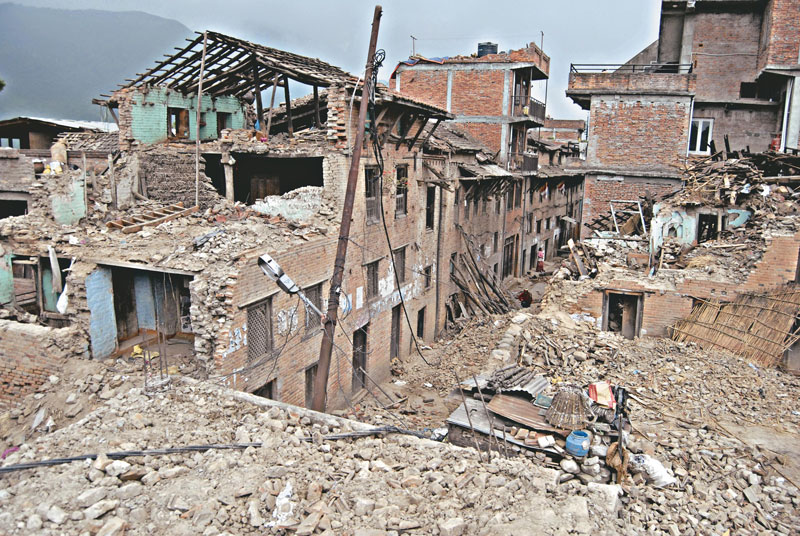Going for Zero Waste post-disaster
Kathmandu
A strong 7.6 on Richter scale earthquake on April 25 hit Nepal in the area near Barpak, Gorkha. The earthquake was followed by many powerful aftershocks and a very powerful one (6.9) hit Nepal on April 26. The quake was followed by more than 300 aftershocks and another powerful aftershock (6.8) on May 12. The earthquakes caused extensive damage to buildings and over 9,000 deaths and injuries and was even felt in Pakistan, India and Bangladesh. Many (historic) buildings collapsed, temples have been ruined, roads destroyed along with the peace of mind of people of Nepal.
Nepal had serious environmental issues prior to the earthquake. These ranged from those caused by a lack of urban services (wastewater management and solid waste collection) to soil erosion. Nepal’s very sustainability had been significantly eroded by resource degradation, including severe deforestation. The earthquake also increased the scale and scope of environmental degradation, generating millions of tons of solid waste in need of handling.
In addition, overcrowded camps have become hotspots for environmental pollution, while reconstruction operations, when they are initiated, are expected to leave a significant environmental footprint.
Millions of people are living under tents and temporary shelters due to the houses being destroyed. After seeing these problems — like destroyed houses and debris not collected even after one month after the earthquake, so many things rise on environment and waste management issues.
The very important thing to be handled is debris in a proper way because most debris is mixed with hazardous items like paints, medicines, fertilisers, pesticides, among others. There are very less resources to handle this big problem and segregation of waste before dumping is also essential.
In the first place, waste should be segregated manually for recycling, reusing and reconstructing purpose. The best way to handle that waste is to coordinate with local recyclers and local government and plan to manage waste accordingly.
After World War II, the European countries supported the recycler to manage waste from the destruction and
most of the waste was managed by recyclers.
After visiting many villages of Kavre, Bhaktapur, Sindupalchowk and Rasuwa for relief works, we found the situation was worst there. Debris of houses were blocking roads. We came to know that the quake affected people of Lalitpur, Bhaktapur and Kathmandu have to pay big amount to the contractor to clear the debris of destroyed houses. The waste taken by the contractor goes directly to the nearest dumping site without segregation. This process will cause a big problem in the future just like people in Sisdol are facing these days — skin problems, pregnant women having respiratory problems, water contamination with hazardous liquid coming from dumped waste and many more.
School buildings can become the source of highly contaminated debris, particularly when school laboratories
are damaged thus releasing harmful chemicals.
Another example is supermarket freezers used for meat storage, which can lead to both explosive and biological hazards due to the degradation and fermentation of meat once the supply of electricity is interrupted.
The best principle to follow to manage is ‘Towards Zero Waste Mission’. Zero waste is a goal that is ethical, economical, efficient and visionary. In the 20th Century, the focus was on waste management and how to get rid of waste efficiently and with minimal damage to our health and environment.
The 21st Century focus needs to be on resource management and sustainability for future generations — the best practices of Zero Waste from many communities all over the world motivating communities.
Zero Waste is about involvement of local people to solve the problem joining hands with the government. The
government can play a vital role in making comprehensive plans for handling waste from the disaster. The mission operation Zero Waste Disaster should be rolled out.
The following points should be followed —
- Segregation of waste should be made compulsory before sending to the dumping site.
- Strict action to be taken against illegal dumping of waste.
- Funds should be mobilised for pre-monsoon cleaning to the affected areas.
- Mandatory recycling, repairing, deconstruction and reuse of waste.
- Mandatory treatment of organic waste, which can be coupled with organic farming.
- Establishment of resource recovery centre.
- Introducing extended produce responsibility.
(The author is the Chairperson of Pragya Seeds Nepal, and Zero Waste Himalaya Resource Person)






